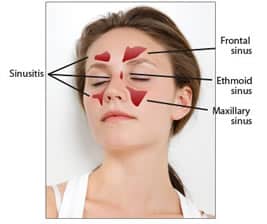Sinusitis and Sinus Headache

Disorders of the sinuses are diagnosed and treated after a careful history is taken and an examination performed. Our conservative approach to the treatment of sinusitis will initially include medication, and if appropriate, allergy treatment. If conservative measures fail to adequately treat a patient’s chronic condition, a CT scan of the sinuses will be requested to diagnose structural blockages and/or polyps obstructing the sinus outflow tracts
If surgery is indicated, the most minimally invasive technique will be utilized, including balloon sinuplasty, endoscopic sinus surgery, and computer image-guided sinus surgery.
Sinusitis is a condition that refers to an inflammation of the lining within the paranasal sinuses.
What causes Sinusitis?
Sinusitis is usually caused by bacteria, a virus, or allergies.
What are common symptoms of Sinusitis?
Sinusitis can be classified by location:
- Maxillary – which causes pain or pressure in the cheek area;
- Frontal- which causes pain or pressure above and behind the eyes;
- Ethmoid – which causes pain or pressure between or behind the eyes; and
- Sphenoid- which causes pain or pressure behind the eyes.
Sinusitis FAQs
Chronic sinusitis occurs when inflammation of the mucous membranes lasts for more than 3 months.
Symptoms of chronic sinusitis include persistent nasal congestion, facial pressure, headaches, nasal discharge, postnasal drip, cough, and a reduced sense of smell.
Ear, nose and throat specialists use an endoscope to examine the inside of the nose and sinuses. A CT scan may be indicated to look for structural issues affecting the drainage of the sinuses.
Treatment may include antibiotics, sometimes for prolonged periods, nasal steroid sprays, saline nasal irrigation, and oral steroids. In some cases, a procedure to ‘open’ and drain the sinuses may be necessary.
